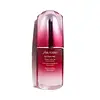What's inside
What's inside
 Key Ingredients
Key Ingredients

 Benefits
Benefits

 Concerns
Concerns

 Ingredients Side-by-side
Ingredients Side-by-side

Water
Skin ConditioningAlcohol Denat.
AntimicrobialGlycerin
HumectantButylene Glycol
HumectantPEG/PPG-17/4 Dimethyl Ether
Skin ConditioningTriethylhexanoin
MaskingCyclohexasiloxane
EmollientDimethicone
EmollientPhenoxyethanol
PreservativeTrehalose
HumectantAmmonium Acryloyldimethyltaurate/Beheneth-25 Methacrylate Crosspolymer
Emulsion StabilisingPEG-14m
Emulsion StabilisingAcrylates/C10-30 Alkyl Acrylate Crosspolymer
Emulsion StabilisingTocopheryl Acetate
AntioxidantPEG/PPG-14/7 Dimethyl Ether
Skin ConditioningRosa Damascena Flower Water
MaskingParfum
MaskingDisodium EDTA
Potassium Hydroxide
BufferingSilica
AbrasiveIsoceteth-10
EmulsifyingLinalool
PerfumingLauryl Betaine
CleansingGinkgo Biloba Leaf Extract
Skin ConditioningGeraniol
PerfumingCitronellol
PerfumingOriganum Majorana Leaf Extract
AntiseborrhoeicNelumbo Nucifera Germ Extract
Skin ConditioningAlcohol
AntimicrobialSodium Carboxymethyl Beta-Glucan
CleansingBHT
AntioxidantThymus Serpyllum Extract
Skin ConditioningPerilla Ocymoides Leaf Extract
TonicSodium Bicarbonate
AbrasiveIris Florentina Root Extract
MaskingSodium Benzoate
MaskingGanoderma Lucidum Stem Extract
Skin ConditioningWater, Alcohol Denat., Glycerin, Butylene Glycol, PEG/PPG-17/4 Dimethyl Ether, Triethylhexanoin, Cyclohexasiloxane, Dimethicone, Phenoxyethanol, Trehalose, Ammonium Acryloyldimethyltaurate/Beheneth-25 Methacrylate Crosspolymer, PEG-14m, Acrylates/C10-30 Alkyl Acrylate Crosspolymer, Tocopheryl Acetate, PEG/PPG-14/7 Dimethyl Ether, Rosa Damascena Flower Water, Parfum, Disodium EDTA, Potassium Hydroxide, Silica, Isoceteth-10, Linalool, Lauryl Betaine, Ginkgo Biloba Leaf Extract, Geraniol, Citronellol, Origanum Majorana Leaf Extract, Nelumbo Nucifera Germ Extract, Alcohol, Sodium Carboxymethyl Beta-Glucan, BHT, Thymus Serpyllum Extract, Perilla Ocymoides Leaf Extract, Sodium Bicarbonate, Iris Florentina Root Extract, Sodium Benzoate, Ganoderma Lucidum Stem Extract
Water
Skin ConditioningGlycerin
HumectantPropanediol
SolventPentylene Glycol
Skin ConditioningPleiogynium Timoriense Fruit Extract
Skin ConditioningPodocarpus Elatus Fruit Extract
Skin ConditioningTerminalia Ferdinandiana Fruit Extract
AntioxidantSodium Acetylated Hyaluronate
HumectantSodium Hyaluronate
HumectantTremella Fuciformis Polysaccharide
Emulsion StabilisingAcacia Seyal Gum Extract
HumectantSr-Spider Polypeptide-1
Skin ProtectingPantothenic Acid
Skin ConditioningPhospholipids
Skin ConditioningSodium Hydroxide
BufferingSpirulina Platensis Extract
Skin ProtectingRaphanus Sativus Root Extract
AstringentCaprylyl Glycol
EmollientChlorphenesin
AntimicrobialTetrasodium Glutamate Diacetate
Polyglyceryl-6 Caprylate
EmulsifyingPolyglyceryl-4 Caprate
EmulsifyingPotassium Sorbate
PreservativePropylene Glycol
HumectantLeuconostoc/Radish Root Ferment Filtrate
Antimicrobial1,2-Hexanediol
Skin ConditioningCitric Acid
BufferingEthylhexylglycerin
Skin ConditioningHydroxyacetophenone
AntioxidantCarrageenan
Xanthan Gum
EmulsifyingSodium Glycolate
BufferingSodium Formate
BufferingPhenoxyethanol
PreservativeParfum
MaskingWater, Glycerin, Propanediol, Pentylene Glycol, Pleiogynium Timoriense Fruit Extract, Podocarpus Elatus Fruit Extract, Terminalia Ferdinandiana Fruit Extract, Sodium Acetylated Hyaluronate, Sodium Hyaluronate, Tremella Fuciformis Polysaccharide, Acacia Seyal Gum Extract, Sr-Spider Polypeptide-1, Pantothenic Acid, Phospholipids, Sodium Hydroxide, Spirulina Platensis Extract, Raphanus Sativus Root Extract, Caprylyl Glycol, Chlorphenesin, Tetrasodium Glutamate Diacetate, Polyglyceryl-6 Caprylate, Polyglyceryl-4 Caprate, Potassium Sorbate, Propylene Glycol, Leuconostoc/Radish Root Ferment Filtrate, 1,2-Hexanediol, Citric Acid, Ethylhexylglycerin, Hydroxyacetophenone, Carrageenan, Xanthan Gum, Sodium Glycolate, Sodium Formate, Phenoxyethanol, Parfum
 Reviews
Reviews

Ingredients Explained
These ingredients are found in both products.
Ingredients higher up in an ingredient list are typically present in a larger amount.
Glycerin is already naturally found in your skin. It helps moisturize and protect your skin.
A study from 2016 found glycerin to be more effective as a humectant than AHAs and hyaluronic acid.
As a humectant, it helps the skin stay hydrated by pulling moisture to your skin. The low molecular weight of glycerin allows it to pull moisture into the deeper layers of your skin.
Hydrated skin improves your skin barrier; Your skin barrier helps protect against irritants and bacteria.
Glycerin has also been found to have antimicrobial and antiviral properties. Due to these properties, glycerin is often used in wound and burn treatments.
In cosmetics, glycerin is usually derived from plants such as soybean or palm. However, it can also be sourced from animals, such as tallow or animal fat.
This ingredient is organic, colorless, odorless, and non-toxic.
Glycerin is the name for this ingredient in American English. British English uses Glycerol/Glycerine.
Learn more about GlycerinParfum is a catch-all term for an ingredient or more that is used to give a scent to products.
Also called "fragrance", this ingredient can be a blend of hundreds of chemicals or plant oils. This means every product with "fragrance" or "parfum" in the ingredients list is a different mixture.
For instance, Habanolide is a proprietary trade name for a specific aroma chemical. When used as a fragrance ingredient in cosmetics, most aroma chemicals fall under the broad labeling category of “FRAGRANCE” or “PARFUM” according to EU and US regulations.
The term 'parfum' or 'fragrance' is not regulated in many countries. In many cases, it is up to the brand to define this term.
For instance, many brands choose to label themselves as "fragrance-free" because they are not using synthetic fragrances. However, their products may still contain ingredients such as essential oils that are considered a fragrance by INCI standards.
One example is Calendula flower extract. Calendula is an essential oil that still imparts a scent or 'fragrance'.
Depending on the blend, the ingredients in the mixture can cause allergies and sensitivities on the skin. Some ingredients that are known EU allergens include linalool and citronellol.
Parfum can also be used to mask or cover an unpleasant scent.
The bottom line is: not all fragrances/parfum/ingredients are created equally. If you are worried about fragrances, we recommend taking a closer look at an ingredient. And of course, we always recommend speaking with a professional.
Learn more about ParfumPhenoxyethanol is a preservative that has germicide, antimicrobial, and aromatic properties. Studies show that phenoxyethanol can prevent microbial growth. By itself, it has a scent that is similar to that of a rose.
It's often used in formulations along with Caprylyl Glycol to preserve the shelf life of products.
Water. It's the most common cosmetic ingredient of all. You'll usually see it at the top of ingredient lists, meaning that it makes up the largest part of the product.
So why is it so popular? Water most often acts as a solvent - this means that it helps dissolve other ingredients into the formulation.
You'll also recognize water as that liquid we all need to stay alive. If you see this, drink a glass of water. Stay hydrated!
Learn more about Water